6 Software Development Trends Witnessed by Developers
Sector: Digital Product, Technology
Author: Hemant Kumar
Date Published: 06/15/2020

Contents
In 2005, Ludvig Strigeus a Swedish software programmer single-handedly developed an internet revolution, in his free time.
You’ve probably heard of uTorrent that has about 150+ million users today.
The interesting part is that he is the same guy who later created Spotify.
But uTorrent only came to the limelight when it was purchased by BitTorrent Inc, and Spotify rose to fame when a full software development team started backing the project. This is true for all kinds of software products in the market today.
The success of the software industry is largely attributed to the efficiency and collaboration it has achieved in the past 10 years. The software development process has undergone major changes that shape today’s software economics.
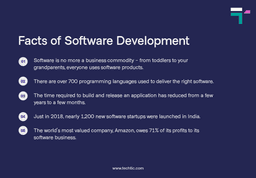
The following points briefly sum up this change.
- Software is no more a business commodity – from toddlers to your grandparents, everyone uses software products.
- There are over 700 programming languages used to deliver the right software.
- The time required to build and release an application has reduced from a few years to a few months.
- Just in 2018, nearly 1,200 new software startups were launched in India.
- The world’s most valued company, Amazon, owes 71% of its profits to its software business.
So, how did all of this happen? How did we go from, “Where do I insert this CD?” to “Give me the download link?”
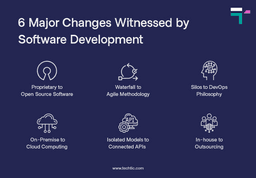
6 Major Changes in Software Development
The answer lies in the methods used to develop and run the software. Let’s see what all has changed over the past decade.
1. Proprietary to Open Source Software
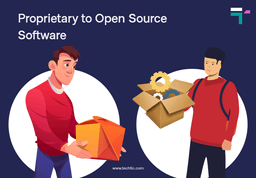
Open Source software is distributed free of cost with permissions to modify the code. This might seem anti-capitalistic but modern-day software has become more about the collective growth of technology over one man’s profit.
From the OS that powers Android phones to the framework that controls Facebook’s appearance, a large number of software products are open source.
Try 100% Risk-Free
20 Hours!
Let us invest the first 20 hours without any hidden fees to see if we are the right fit for your organization.
Get started
Top organizations like Microsoft, Google, IBM, Adobe, and more are actively making their inventions open source to boost software development.
The result is that while the cost and effort needed for creating new software decreased, the scope of innovation multiplied. This empowers a Software Development Company like us to offer the best products to our clients.
2. Waterfall to Agile Methodology
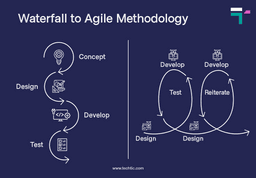
Most of the early-age software was developed like a long marathon run with set patterns and a linear approach. The Waterfall Model.
But today, the new approach is to run shorter 100 m sprints that allow reiterations and a more collaborative environment. The Agile methodology.
Modern software is split up into several smaller components that are incrementally developed, rather than one giant block. This new paradigm shift has made software development much more robust, adaptable, and efficient.
Happily, our Software Development Company also uses the Agile methodology in all of our projects.
3. Silos to DevOps Philosophy
It took a long sweet period of time before we realized that the people developing the software and the people managing its operation should work together. The result was DevOps.
The early concept was to create silos of developers and operations engineers. But DevOps has brought seemingly disparate processes of the software development lifecycle together. Engineers who code the software work closely with engineers who test it, enabling both to contribute to each other.
The DevOps philosophy has changed the software development industry in several ways. DevOps particularly applies to software development companies that are responsible for creating impactful software. DevOps achieves the following benefits.
- Developing and deploying applications faster.
- Making applications reliable under varying circumstances.
- Enabling applications to perform well for 10 or 10,000 users.
- Improving security in business domains.
4. On-Premise to Cloud Computing
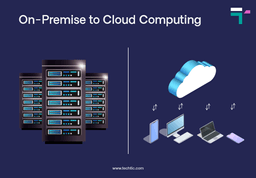
Cloud computing is the idea to take your software workloads to virtual servers hosted on the internet (or the cloud). Before cloud computing, being able to afford internet applications was extremely limited.
The advent of cloud computing acts as a catalyst for software development. As it becomes easier to offer your software to more people at a lower cost around the world, the business viability of software also gets better.
Today, 90% of companies around the world host their software on the cloud, which includes us! Cloud computing makes dramatic improvements in the infrastructure required to run software online.
It’s simple to prove how beneficial cloud computing is.
If you wanted to share 15 GB worth of data with your friend in another city, you’ll have to buy a flash drive worth $10-20 flash drive and spend money on the travel.
Whereas sharing it on Google Drive is actually free.
5. Isolated Models to Connected APIs
This term gets thrown around a lot because it’s actually that essential in the modern software development scene.
An API (Application Programming Interface) is a method by which two disparate systems can share data and functionality. APIs are critical in connecting the diverse universe of software products, making life easy for integrations.
APIs have existed since 2000 but only in the past decade have their true potential realized. A common example is Google Cloud Vision API using which you can enable image intelligence in your software products.
You don’t have to build the necessary AI algorithms for it. Simply plug in the API and use it in your own implementation. The concept of APIs has made the internet a highly connected environment that benefits everyone from the software developer to the end-user.
6. In-house to Outsourcing
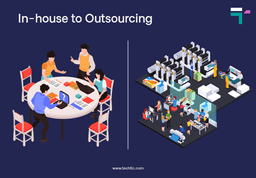
The last factor that has changed software development to a great extent is the outsourcing model. This is how top organizations based in America get their software made from Engineers sitting in India.
The global IT and Software Outsourcing Industry is valued at $92.5 billion U.S. dollars as of 2019. It enables companies to procure winning software at lower costs, as it continues to create jobs in the provider countries. This sharing of human resources across boundaries has actually boosted innovation and unprecedented growth in software development.
Conclusion
Software is getting easier to make, smarter to work with, and increasingly effective at its job, all thanks to the new custom software development methodologies.
There is no debate on the fact that software success depends upon how it is developed. Because the how determines, whether it will be economically viable and technically feasible. An even more important question is, are you developing it the right way?
At Techtic Solutions, we answer that question confidently and definitely. From Open Source to Outsource, we give your idea the industry-leading advantage it needs, to fly. Or so, our clients from 15+ industries claim. Verify for yourself by getting in touch with us at info@techtic.com for the next big idea you want to back with winning software.
Latest Tech Insights!
Join our newsletter for the latest updates, tips, and trends.



